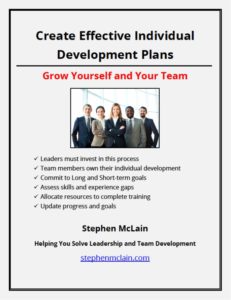Leaders often talk about the importance of creating individual development plans with their team members, but are leaders approaching them correctly? Are they putting in real effort to create effective plans that achieve positive results? Our first duty as leaders is to grow our people.
While serving in the Army for over 20 years, an individual development plan provided focus and possibilities for what I wanted to accomplish in my profession and my personal life. My own plans were often created as a simple Word document with goals, courses, certifications, a long-term calendar and future job roles.
Six Steps for Building and Developing Accounting and Finance Team Collaboration
As a leader, I was inconsistent in helping the members of my teams with creating effective individual development plans. My focus was always to coach and mentor my teams, but did not necessarily require a written plan with goals. After reflecting on this over the years, it is essential, as leaders, we help shape written plans, and review them throughout the year.
I do also believe that each person must own their personal development regardless of the commitment of leadership. For they must, in fact, figure out what their future is, and they must complete the work. Without a personal pledge to do the work, the plan becomes meaningless.
“The only thing worse than training your employees and having them leave is not training them and having them stay.” — Henry Ford, Founder, Ford Motor Company
What categories of training should be included in individual development plans?
Consider all types of training opportunities. Formal courses, both online and traditional class room work, can deliver a huge impact. But, also, free training sessions on Khan Academy or Udemy, can help you improve technical skills. Microsoft and many others offer powerful training videos for free to improve skills. Talk to the training team in your company to see what they offer.
Don’t overlook books and professional journals as a part of any individual development plan. These can provide current best practices and “how-to” lists to build knowledge that can directly improve job performance. Be observant on dates of publication especially in rapidly changing fields.
Certifications provide an opportunity to earn professional recognition as an expert in a specific field. Additionally, higher compensation and greater responsibility may be available once earned. The professional certifications that are known to bring greater compensation are Project Manager (PMP), Certified Public Accountant and many other IT certifications.
Process for creating effective individual development plans:
- Set long-term and short-term goals. What long-term job do you want? Backwards plan to determine what steps are necessary to achieve this position.
- What is your current level of achievement and experience? You must know where you now stand before you can determine how you can accomplish your goals. Where are you in your life? Is your personal life changing soon? What have you achieved on your goals list?
- Review previous evaluations for “needs improvements”. Performance reviews can highlight a few areas that others can see which will require some work. It may be a technical skill or even a soft skill. But this can matter as you determine where your career should go.
- Solicit peer feedback. This is another great avenue for feedback from others.
- List out areas that you have interest in, but may not necessarily work on in the next year.
- Assess skill and experience gaps.
- How can the gaps be filled and your evaluation “needs improvements” be corrected?
- What certifications and professional licensing will you need to accomplish to meet your goals and to build your professional credentials?
- Research available courses, training, conferences, professional journals and books.
- Is there a professional organization you can join to further your career or subscribe to a professional journal or periodical to gain knowledge in your field?
- Prioritize training opportunities to meet your goals.
- Establish a timeline.
- Request resources to support the plan. Is there money in the budget for training? Do you have to pay out-of-pocket?
- Schedule training and update the timeline. Match your available resources to the training you need.
- Complete the training.
- Review the plan and update with changes and results. Document your progress and achievements.
- Continual communication between supervisor and direct reports.
This process may seem daunting, but it creates an excellent road map from understanding where you are to how you can achieve your goals. Mapping out a career shows commitment to the organization, the team and to yourself. Human resources and senior leaders must ensure this process is done correctly and with the right attitude. The company must promote growing its people.
Several key issues to overcome in the creation of individual development plans.
An individual development plan often gets rushed because it is another high pressure “to-do” item from human resources and senior leadership. I like leaders to be involved with development because it can encourage accountability, and it provides an opportunity to know your team members. Ensure this process does not become a “check the block” program, because to do so would mean that leadership has failed the most important feature in business: our people
Human resource managers and senior leaders should be wary of managers who are not helping their direct reports create individual development plans. A manager’s performance rating and compensation level should be tied to how they grow their team. However, training for managers may be required to help them in this role. It is also possible that managers may believe it’s not important. Growing people must be a high priority for every organization.
What if a direct report doesn’t want to talk about their goals? Team members’ reluctance to be completely truthful in their long-term goals relates to trust issues. Goals may be in direct competition with their supervisor, and they desire to not directly challenge that situation. Further, their long-term goals may take them away from the company and, again, they won’t want to communicate that in the present.
Can managers become fearful of losing a direct report? Don’t stress that you may lose your people to another organization. The greatest by-product of good leadership is to see your team members grow and take on greater responsibility, even if it is somewhere else.
How do we approach the employee who prefers to remain in the same duty position? Each person has a different reason for employment. The best scenario is to focus on duty specific “needs improvement” skills such as public speaking or a technical skill. This team member who seeks no change or advancement should become the expert in their position as they work through the same cycle each year with the same deliverables.
If you are a human resources professional, a manager or small business owner, it is time for you to review how an individual development plan is created in your organization. What is the process? Are they effective? Do they get results?
How can you improve the process in your business to create an effective individual development plan for every team member?
“An organization’s ability to learn, and translate that learning into action rapidly is the ultimate competitive advantage.” — Jack Welch, former General Electric CEO
Please comment or email me at comment@stephenmclain.com.
Copyright 2017 – Stephen McLain



